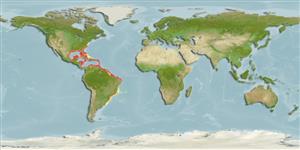Issue
Author may probably be Cuvier 1816.
Environment: milieu / climate zone / depth range / distribution range
Écologie
marin démersal. Tropical
Western Atlantic Ocean.
Taille / Poids / Âge
Maturity: Lm ? range ? - ? cm
Max length : 34.1 cm TL mâle / non sexé; (Ref. 122735); common length : 20.0 cm TL mâle / non sexé; (Ref. 5217); poids max. publié: 119.30 g (Ref. 118626)
Épines dorsales (Total) : 9; Rayons mous dorsaux (Total) : 21 - 23; Épines anales: 3; Rayons mous anaux: 17 - 19. Pelvic fins relatively short at all sizes, becoming nearly rudimentary (Ref. 51310).
Adults occur over continental shelves (Ref. 5217). No real fishery (Ref. 51310). Edibility not known (Ref. 51310).
Life cycle and mating behavior
Maturities | Reproduction | Spawnings | Egg(s) | Fecundities | Larves
Smith-Vaniz, W.F., 2003. Carangidae. Jacks and scads (bumpers, pompanos, leatherjacks, amberjacks, pilotfishes, rudderfishes). p. 1426-1468. In K.E. Carpenter (ed.) FAO species identification guide for fishery purposes. The living marine resources of the Western Central Atlantic. Vol. 3: Bony fishes part 2 (Opistognathidae to Molidae), sea turtles and marine mammals. (Ref. 51310)
Statut dans la liste rouge de l'IUCN (Ref. 130435)
Menace pour l'homme
Harmless
Utilisations par l'homme
Pêcheries: pêcheries vivrières
Outils
Articles particuliers
Télécharger en XML
Sources Internet
Estimates based on models
Preferred temperature (Ref.
123201): 22.4 - 27.5, mean 25.9 °C (based on 164 cells).
Phylogenetic diversity index (Ref.
82804): PD
50 = 0.5039 [Uniqueness, from 0.5 = low to 2.0 = high].
Bayesian length-weight: a=0.01479 (0.00880 - 0.02485), b=2.86 (2.72 - 3.00), in cm total length, based on LWR estimates for this species & (Sub)family-body (Ref.
93245).
Niveau trophique (Ref.
69278): 4.0 ±0.7 se; based on size and trophs of closest relatives
Generation time: 1.8 ( na - na) years. Estimated as median ln(3)/K based on 2
growth studies.
Résilience (Ref.
120179): Haut, temps minimum de doublement de population inférieur à 15 mois (Preliminary K or Fecundity.).
Fishing Vulnerability (Ref.
59153): Low vulnerability (24 of 100).
